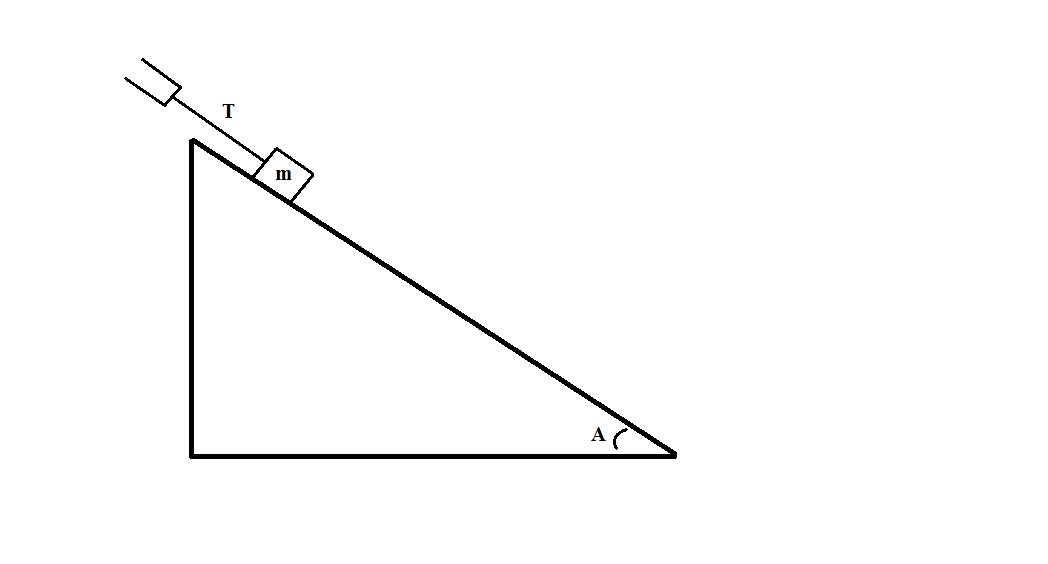All AP Physics 1 Resources
Example Questions
Example Question #21 : Tension
A spring is attached to a rope that is hanging from the ceiling. A block of mass 


Ignore the mass of the rope and spring and assume simple harmonic motion.
There are two forces contributing to tension in the rope: the weight of the mass and the force of the spring. When the tension of the rope is zero, we know that these two forces are equal and opposite. Furthermore, the weight of the mass will always be pointed down, so the force of the spring (relative to the rope) will be pointed upward. This occurs in a moment of compression of the spring. With that said, we just need to solve the following expression:
Rearranging for displacement:
Plugging in our values:
Example Question #211 : Specific Forces
Jennifer has a mass of 


Example Question #211 : Specific Forces
A scuba diver and his equipment have a total mass of 


None of the other answers
If the diver stays at a constant depth, we know that all the forces on him must cancel out:
We can write out all of the forces on the diver, using force of the flippers to denote the vertical force he exerts to stay at constant depth:
The force of gravity and bouyancy counteract each other, so they will have opposite signs. If we assume that the force of flippers will be down, we can write:
The bouyancy force is simply the weight of the water displaced by the diver. Plugging in expressions for the latter two forces:
We have values for all of these, allowing us to solve:
Example Question #212 : Forces
A spring is attached to the top of a box. The constant of the spring is 


Since the spring is initially in equilibrium, we can write:
There are three forces in play: spring force, gravitational force, and the additional force resulting from the acceleration of the box. If we say that any forces pointing downward are positive, we can write:
The force resulting from the additional acceleration must be subtracted since all forces cancel out and both of the other two forces are postive. This means that the resulting force from acceleration is pointing upward; Thus, the box is accelerating downward (think about riding in an elevator).
Substituting expressions for each force, we get:
Rearrange to solve for the acceleration of the box:
Example Question #213 : Forces
Consider the following scenario:

If the force of tension is 


There are three relevant forces in play in this scenario: friction, tension, and gravity.
We can use Newton's second law to create an expression for the net force:
Substituting expressions in for the forces, we get:
Rearrange to solve for the mass:
Use our given values to solve:
Example Question #821 : Ap Physics 1
An astronaut is in orbit around the earth. The feeling of weightlessness that he experiences is due to the absence of which force?
Normal force
Frictional force
Gravitational force
Buoyant force
Normal force
The correct answer is normal force. Normal force will occur when the astronaut is standing on a surface, which will push back on him. Gravity is present since the astronaut is in orbit (gravity provides the centripetal force). The feeling of weightlessness he experiences is due to the absence of a surface to push back on him/her.
Example Question #215 : Forces
Consider a 


To solve this problem, we need to look at all of the forces acting on the sphere, this includes the force of gravity, the normal force provided by the scale, and the buoyancy force. If the object is in equilibrium, the net force acting on the sphere must be zero.
Example Question #821 : Ap Physics 1
Suppose that a student pushes his physics textbook across the table with his hand. In doing so, what type of force is acting on the book?
Strong force
Weak force
Electromagnetic force
Gravitational force
Electromagnetic force
If a person were to use their hand to push a book across the table, the type of force that their hand is applying to the book is classified as an electromagnetic force. Even though this may not seem intuitive, the reason is that the electrostatic repulsion of the atoms in the person's hand repel the atoms in the book. Due to this electrostatic repulsion between the atoms in the person's hand and the atoms in the book, the force is electromagnetic.
Gravitational forces occur due to gravity, that is, from an attraction between any two objects with mass. The strong and weak forces are both nuclear forces that act only across very, very short distances. Generally, these forces are only significant at the sub-atomic level in the atom's nucleus, and thus do not have a role at greater distances (such as between the person's hand and the book).
Example Question #217 : Forces
Mass of Mars:
Universal gravitation constant:
Radius of Mars:
A buggy on the surface of Mars locks up it's break and slides on Martian ice. If the buggy was traveling at 

None of these
The normal force will be equal to the magnitude of the force of gravity pushing the buggy into the ground.
Using definition of frictional force and work equation:
Combining equations:
Canceling out the mass of the buggy and plugging in values:
Solving for
Example Question #213 : Forces
An adventurous teenager has decided to pick up skydiving. If the teen has a mass of 



When a diver reaches terminal velocity, we know that the net force on the diver is equal to 0. There are two forces acting on the diver, gravity and drag, so we can say that:
Plugging in expressions, we get:
Rearranging for density, we get:
We have all of these values, so we can plug and chug:
All AP Physics 1 Resources



























































































